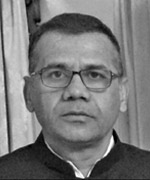The government should act fast to provide CAPFs personnel better service conditions and other basic facilities
 R.C. Sharma
R.C. Sharma
The Central Armed Police Forces (CAPFs) comprises Assam Rifles, Border Security Force (BSF), Central Industrial Security Force (CISF), Central Reserve Police Force (CRPF), Indo-Tibetan Border Police (ITBP) and Sashastra Seema Bal (SSB) with the combined strength of about one million function under the administrative control of the ministry of home affairs (MHA). Subordinate officers, under officers and jawans constitute 98.5 per cent of the total strength of CAPF. The remaining 1.5 per cent is the officer cadre. Clearly, the jawans are the backbone of security and territorial integrity of a nation. They keep our democracy vibrant and nation safe working 24x7x365 in harsh climatic and geographical conditions. What British Prime Minister Winston S. Churchill said aptly applies to CAPFs soldiers even today: “We sleep safely at night because rough men stand ready to visit violence on those who would harm us”.
The CAPFs has a defined role mandated under respective act and rules, which it has been executing professionally under difficult and adverse situations, frequently earning acclaim from the government and citizens. In an essay on ‘Counter-Insurgency in Jammu and Kashmir: A tale of Indian Security Forces’ (published in National Security Challenges edited by Col Raman Deep Singh Sandhu and Dr Manjari Singh), Anns George KG writes, ‘The BSF was a unique force at the time of its deployment in the Kashmir valley. It possessed characteristics of both the military and police force. It was a regular infantry with policing duties. This combination of policing skill and infantry style was very well suited for the COIN operations in Jammu and Kashmir. As a result, the BSF was the first group that initially succeeded in COIN operations in Jammu and Kashmir’.
On the CRPF, he writes, ‘When the J&K police was ineffective in controlling mob violence, law and order situation got worse and the CRPF was deployed in the valley. The CRPF was an effective force in controlling mob violence and riots. Due to this, the CRPF was able to rein in deteriorating law and order situation in J&K. With reduction in the BSF deployment since 2003, the CRPF was given more focus to tackle the insurgency problem in J&K’. What he writes for the BSF and the CRPF is true for other forces too.

CAPFs men have never allowed poor service conditions to become a hindrance in performance of operational and administrative duties. Despite being aware of the inadequacies, government and forces headquarters have not paid the desired attention to improve service conditions and satisfaction index of CAPFs men and officers. Rather, the government and senior leadership have compelled officers and men to approach courts for relief since forces headquarters and MHA have been indecisive on important issues. An increase in court cases is an indicator of the government’s disdain to genuine concerns of CAPFs soldiers, which effect morale and motivation. The government seems least bothered about a dip in morale and motivation and its adverse effect on operational performance.
Are CAPFs jawans, subordinate officers and other officers happy with human resource, operational and administrative management? Are general duty cadre officers happy with their cadre management? Is the government fair to jawans and officers of CAPFs in terms of improvement in their service conditions, promotions, financial benefits and timely disbursement of benefits to personnel both serving and retired? These questions may be trivial for CAPFs top hierarchy and MHA but matter a lot for dignity and self-respect of men and officers.
Service Conditions
The Parliamentary Standing Committee on Home Affairs’ report 214-215 dwelled upon working conditions in the CAPFs. It focuses on deployment in difficult geographical and climatic conditions, personnel management, pay and pension, stagnation, prolonged working hours, attrition, inadequate infrastructure, lack of basic amenities and medical facilities. Here’s a quick low-down on service conditions.
Promotional Avenues: Even today, CAPFs men and general duty cadre officers suffer the worst kind of stagnation. The government has not been able to maintain uniformity in promotions amongst various forces and cadres within these forces leading to heartburn, jealousy and inter cadre rivalry, thus affecting discipline, morale and motivation. The forces have failed to maintain their own residency period parameters for promotions leading to acute stagnation. The MHA instead of restoring uniformity in promotions have encouraged inter-cadre rivalry by pitching one cadre against other, by framing rules which encourage cadre rivalry. The problem of stagnation is very acute in the BSF and the CRPF. For example, in the BSF,
- The residency period for promotion from constable to head constable is eight years. Yet, those recruited in 2000 are still constables despite completing 20 years of service.
- The residency period for promotion from head constable to assistant sub-inspector (ASI) is five years. Yet, a miniscule number of those recruited in 1990 have made it to head constable and are still aspiring to be ASIs.
- Constables of 1988 are ASIs now, though they should have been deputy commandants now.
- Constables of 1983 are sub-inspectors and inspectors whereas they should be second-in-command.
- It takes about 12 years of service as inspector for promotion to assistant commandant. Yet, sub-inspector direct entries of 2003 are still inspectors whereas they should have been deputy commandants.
- Assistant commandant direct entries in the BSF are still deputy commandants after 18 years of service, when they should have been commandants in accordance with residency period norms. Officers of December 1990 are still commandants despite putting in about 30 years of service. They should have been additional director generals now.
You must be logged in to view this content.

